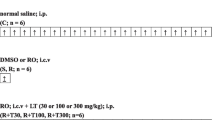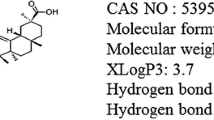Abstract
Rotenone (ROT)-induced neurotoxicity has been used for decades as an animal model of Parkinson’s disease (PD) in humans. This model exhibits pathophysiological features similar to those reported in patients with PD, namely, striatal nitrosative and oxidative stress, mitochondrial dysfunction, and neural cytoarchitecture alteration. (−)Epigallocatechin-3-gallate (EGCG), the most abundant and potent green tea catechin, has notable anti-oxidative, anti-inflammatory, and neuroprotective effects. The objective of the present study was to investigate the potential protective effects of EGCG on ROT-induced motor and neurochemical dysfunctions in rats. Furthermore, we also aimed to study the neuroprotective mechanisms underlying these effects. ROT treatment (0.5 mg/kg s.c., 21 days) reduced body weight and induced significant motor impairments as assessed using an open-field test, rotarod test, grip strength measurement, and beam-crossing task. EGCG treatment (100 or 300 mg/kg i.p., 60 min prior to ROT administration, 21 days) prevented most of the ROT-induced motor impairments. Moreover, EGCG treatment reduced ROT-induced nitric oxide (NO) level and lipid peroxidation (LPO) production; increased the activity of succinate dehydrogenase (SDH), ATPase, and ETC enzymes and the levels of catecholamines in the striatum; and reduced the levels of neuroinflammatory and apoptotic markers. These results demonstrate the possible neuroprotective effects of EGCG against ROT-induced motor impairments, including anti-oxidatory effect, prevention of mitochondrial dysfunction, prevention of neurochemical deficiency, anti-neuroinflammatory effect, and anti-apoptotic effect. This is the first report about the neuroprotective effect of EGCG against ROT-induced motor impairments, and the above evidence provides a potential clinically relevant role for EGCG in delaying or treating human PD.








Similar content being viewed by others
References
Anusha C, Sumathi T, Joseph LD (2017) Protective role of apigenin on rotenone induced rat model of Parkinson's disease: Suppression of neuroinflammation and oxidative stress mediated apoptosis. Chem Biol Interact 269:67–79
Ball N, Teo WP, Chandra S, Chapman J (2019) Parkinson's Disease and the Environment. Front Neurol 10:218
Beers RF Jr, Sizer IW (1952) A spectrophotometric method for measuring the breakdown of hydrogen peroxide by catalase. J Biol Chem 195:133–140
Chen CN, Chang KC, Lin RF, Wang MH, Shih RL et al (2016) Nitric oxide pathway activity modulation alters the protective effects of (-)Epigallocatechin-3-gallate on reserpine-induced impairment in rats. Behav Brain Res 305:198–211
Chen S, Wang Z, Ma Y, Zhang W, Lu J et al (2018) Neuroprotective Effects and Mechanisms of Tea Bioactive Components in Neurodegenerative Diseases. Molecules 23:512
Costa C, Belcastro V, Tozzi A, Di Filippo M, Tantucci M et al (2008) Electrophysiology and pharmacology of striatal neuronal dysfunction induced by mitochondrial complex I inhibition. J Neurosci 28:8040–8052
Denny JKM, Muralidhara (2015) Combined oral supplementation of fish oil and quercetin enhances neuroprotection in a chronic rotenone rat model: relevance to Parkinson's disease. Neurochem Res 40:894–905
Dickson DW (2018) Neuropathology of Parkinson disease. Parkinsonism Relat Disord 46(Suppl 1):S30–S33
Ellman GL (1959) Tissue sulfhydryl groups. Arch Biochem Biophys 82:70–77
Erbaş O, Yılmaz M, Taşkıran D (2016) Levetiracetam attenuates rotenone-induced toxicity: A rat model of Parkinson's disease. Environ Toxicol Pharmacol 42:226–320
Farombi EO, Awogbindin IO, Farombi TH, Oladele JO, Izomoh ER et al (2019) Neuroprotective role of kolaviron in striatal redo-inflammation associated with rotenone model of Parkinson's disease. Neurotoxicology 28:132–141
Fonnum F, Lock EA (2004) The contributions of excitotoxicity, glutathione depletion and DNA repair in chemically induced injury to neurones: exemplified with toxic effects on cerebellar granule cells. J Neurochem 88:513–531
Gan RY, Li HB, Sui ZQ, Corke H (2018) Absorption, metabolism, anti-cancer effect and molecular targets of epigallocatechin gallate (EGCG): An updated review. Crit Rev Food Sci Nutr 58(6):924–941
Green LC, Wagner DA, Glogowski J, Skipper PL, Wishnok JS et al (1982) Analysis of nitrate, nitrite, and [15N]nitrate in biological fluids. Anal Biochem 126:131–138
Grünewald A, Kumar KR, Sue CM (2019) New insights into the complex role of mitochondria in Parkinson's disease. Prog Neurobiol 177:73–93
Hashem IAT, Yaqoob I, Anuar NB, Mokhtar S, Gani A et al (2015) The rise of “big data” on cloud computing: review and open research issues. Inf Syst 47:98–115
Hashimoto M, Tanabe Y, Fujii Y, Kikuta T, Shibata H et al (2005) Chronic administration of docosahexaenoic acid ameliorates the impairment of spatial cognition learning ability in amyloid beta-infused rats. J Nutr 135:549–555
Johnson ME, Bobrovskaya L (2015) An update on the rotenone models of Parkinson’s disease: their ability to reproduce the features of clinical disease and model gene-environment interactions. Neurotoxicology 46:101–116
Kandil EA, Abdelkader NF, El-Sayeh BM, Saleh S (2016) Imipramine and amitriptyline ameliorate the rotenone model of Parkinson's disease in rats. Neuroscience 332:26–37
Khadrawy YA, Salem AM, El-Shamy KA, Ahmed EK, Fadl NN et al (2017) Neuroprotective and Therapeutic Effect of Caffeine on the Rat Model of Parkinson's Disease Induced by Rotenone. J Diet Suppl 14:553–572
Kim HS, Quon MJ, Kim JA (2014) New insights into the mechanisms of polyphenols beyond antioxidant properties; lessons from the green tea polyphenol, epigallocatechin 3-gallate. Redox Biol 10:187–195
Konnova EA, Swanberg M (2018) Animal Models of Parkinson’s Disease. In: Stoker TB, Greenland JC (eds) Parkinson’s Disease: Pathogenesis and Clinical Aspects [Internet]. Codon Publications, Brisbane chapter 5
Korhonen R, Lahti A, Kankaanranta H, Moilanen E (2005) Nitric oxide production and signaling in inflammation. Curr Drug Targets Inflamm Allergy 4:471–479
Kouli A, Torsney KM, Kuan WL (2018) Parkinson’s Disease: Etiology, Neuropathology, and Pathogenesis. In: Stoker TB, Greenland JC (eds) Parkinson’s Disease: Pathogenesis and Clinical Aspects [Internet]. Codon Publications, Brisbane chapter 1
Kumar P, Kalonia H, Kumar A (2011) Novel protective mechanisms of antidepressants against 3-nitropropionic acid induced Huntington's-like symptoms: a comparative study. J Psychopharmacol 25:1399–13411
Lowry OH, Rosebrough NJ, Farr AL, Randall RJ (1951) Protein measurement with the Folin phenol reagent. J Biol Chem 193:265–275
Mancini E, Beglinger C, Drewe J, Zanchi D, Lang UE et al (2017) Green tea effects on cognition, mood and human brain function: A systematic review. Phytomedicine 34:26–37
Mancuso M, Coppede F, Migliore L, Siciliano G, Murri L (2006) Mitochondrial dysfunction, oxidative stress and neurodegeneration. J Alzheimers Dis 10:59–73
Mansour RM, Ahmed MAE, El-Sahar AE, El Sayed NS (2018) Montelukast attenuates rotenone-induced microglial activation/p38 MAPK expression in rats: Possible role of its antioxidant, anti-inflammatory and antiapoptotic effects. Toxicol Appl Pharmacol 358:76–85
Michel HE, Tadros MG, Esmat A, Khalifa AE, Abdel-Tawab AM (2017) Tetramethylpyrazine Ameliorates Rotenone-Induced Parkinson's Disease in Rats: Involvement of Its Anti-Inflammatory and Anti-Apoptotic Actions. Mol Neurobiol 54(7):4866–4878
Misra HP, Fridovich I (1972) The role of superoxide anion in the autoxidation of epinephrine and a simple assay for superoxide dismutase. J Biol Chem 247:3170–3175
Moreadith RW, Fiskum G (1984) Isolation of mitochondria from ascites tumor cells permeabilized with digitonin. Anal Biochem 137:360–367
Navarro A, Gomez C, López-Cepero JM, Boveris A (2004) Beneficial effects of moderate exercise on mice aging: survival, behavior, oxidative stress, and mitochondrial electron transfer. Am J Phys Regul Integr Comp Phys 286:R505–R511
Ohkawa H, Ohishi N, Yagi K (1979) Assay for lipid peroxides in animal tissues by thiobarbituric acid reaction. Anal Biochem 95:351–358
Ojha S, Javed H, Azimullah S, Abul Khair SB, Haque ME (2015) Neuroprotective potential of ferulic acid in the rotenone model of Parkinson's disease. Drug Des Devel Ther 9:5499–510
Palle S, Neerati P (2018) Improved neuroprotective effect of resveratrol nanoparticles as evinced by abrogation of rotenone-induced behavioral deficits and oxidative and mitochondrial dysfunctions in rat model of Parkinson's disease. Naunyn Schmiedebergs Arch Pharmacol 391(4):445–453
Patel BA, Arundell M, Parker KH, Yeoman MS, O'Hare D (2005) Simple and rapid determination of serotonin and catecholamines in biological tissue using high-performance liquid chromatography with electrochemical detection. J Chromatogr B Anal Technol Biomed Life Sci 818:269–276
Pennington RJ (1961) Biochemistry of dystrophic muscle. Mitochondrial succinate-tetrazolium reductase and adenosine triphosphatase. Biochem J 80:649–654
Perez-Lloret S, Barrantes FJ (2016) Deficits in cholinergic neurotransmission and their clinical correlates in Parkinson's disease. NPJ Parkinsons Dis 2:16001
Pervin M, Unno K, Ohishi T, Tanabe H, Miyoshi N et al (2018) Beneficial Effects of Green Tea Catechins on Neurodegenerative Diseases. Molecules 23:1297
Prasad SN, Muralidhara (2013) Neuroprotective efficacy of eugenol and isoeugenol in acrylamide-induced neuropathy in rats: behavioral and biochemical evidence. Neurochem Res 38:330-345.
Sanjari Moghaddam H, Zare-Shahabadi A, Rahmani F, Rezaei N (2017) Neurotransmission systems in Parkinson's disease. Rev Neurosci 28:509–536
Scholl C, Lepper A, Lehr T, Hanke N, Schneider KL et al (2018) Population nutrikinetics of green tea extract. PLoS One 13:e0193074
Sharma N, Jamwal S, Kumar P (2016) Beneficial effect of antidepressants against rotenone induced Parkinsonism like symptoms in rats. Pathophysiology 23:123–134
Sharma S, Kumar P, Deshmukh R (2018) Neuroprotective potential of spermidine against rotenone induced Parkinson's disease in rats. Neurochem Int 116:104–111
Singh NA, Mandal AK, Khan ZA (2016) Potential neuroprotective properties of epigallocatechin-3-gallate (EGCG). Nutr J 15:60
Soung HS, Wang MH, Tseng HC, Fang HW, Chang KC (2015) (-)Epigallocatechin-3-gallate decreases the stress-induced impairment of learning and memory in rats. Neurosci Lett 602:27–32
Tapias V, McCoy JL, Greenamyre JT (2019) Phenothiazine normalizes the NADH/NAD+ ratio, maintains mitochondrial integrity and protects the nigrostriatal dopamine system in a chronic rotenone model of Parkinson's disease. Redox Biol 24:101164
Thangarajan S, Deivasigamani A, Natarajan SS, Krishnan P, Mohanan SK (2014) Neuroprotective activity of L-theanine on 3-nitropropionic acid-induced neurotoxicity in rat striatum. Int J Neurosci 124:673–684
Tseng HC, Wang MH, Soung HS, Chang Y, Chang KC (2015) (-)Epigallocatechin-3-gallate prevents the reserpine-induced impairment of short-term social memory in rats. Behav Pharmacol 26:741–747
Wang MH, Lin RF, Tseng HC, Soung HS, Chang KC et al (2015) (-) Epigallocatechin-3-gallate attenuates reserpine-induced orofacial dyskinesia and oxidative stress in rat striatum. Pharmacol Biochem Behav 131:71–76
Zaitone SA, Ahmed E, Elsherbiny NM, Mehanna ET, El-Kherbetawy MK et al (2019) Caffeic acid improves locomotor activity and lessens inflammatory burden in a mouse model of rotenone-induced nigral neurodegeneration: Relevance to Parkinson's disease therapy. Pharmacol Rep 71:32–41
Zhang L, Hao J, Zheng Y, Su R, Liao Y, Gong X, Liu L, Wang X (2018) Fucoidan Protects Dopaminergic Neurons by Enhancing the Mitochondrial Function in a Rotenone-induced Rat Model of Parkinson's Disease. Aging Dis 9(4):590–604
Acknowledgment
The authors thank Persistent BioMed Editing services located in Philadelphia, U.S.A. for their valuable editing and proof-reading of the current manuscript.
Funding
This study was supported by the Mackay Memorial Hospital (MMH-107-89) and Shin Kong Wu Ho-Su Memorial Hospital (SKH-8302-106-DR-23).
Author information
Authors and Affiliations
Corresponding author
Ethics declarations
Conflict of Interest
The authors declare that they have no conflict of interest.
Additional information
Publisher’s Note
Springer Nature remains neutral with regard to jurisdictional claims in published maps and institutional affiliations.
Rights and permissions
About this article
Cite this article
Tseng, HC., Wang, MH., Chang, KC. et al. Protective Effect of (−)Epigallocatechin-3-gallate on Rotenone-Induced Parkinsonism-like Symptoms in Rats. Neurotox Res 37, 669–682 (2020). https://doi.org/10.1007/s12640-019-00143-6
Received:
Revised:
Accepted:
Published:
Issue Date:
DOI: https://doi.org/10.1007/s12640-019-00143-6




